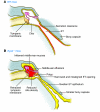Can you hear me now? A genetic model of otitis media with effusion
- PMID: 18219392
- PMCID: PMC2213373
- DOI: 10.1172/JCI33716
Can you hear me now? A genetic model of otitis media with effusion
Abstract
Otitis media with effusion (OME) is characterized by the occurrence of fluid in the middle-ear cavity in the absence of any signs of acute ear infection and occurs most frequently in children with auditory or eustachian tube dysfunction. Its chronic form is an important clinical issue for pediatricians and otologists alike. The study by Depreux et al. in this issue of the JCI shows that absence of the transcriptional activator Eya4 in knockout mice results in abnormal structuring of the eustachian tube, thus predisposing these animals to OME (see the related article beginning on page 651). The development of this genetics-based animal model is an important advance for understanding OME and for exploring new avenues of treatment.
Figures


Comment on
-
Eya4-deficient mice are a model for heritable otitis media.J Clin Invest. 2008 Feb;118(2):651-8. doi: 10.1172/JCI32899. J Clin Invest. 2008. PMID: 18219393 Free PMC article.
Similar articles
-
Eya4-deficient mice are a model for heritable otitis media.J Clin Invest. 2008 Feb;118(2):651-8. doi: 10.1172/JCI32899. J Clin Invest. 2008. PMID: 18219393 Free PMC article.
-
A novel model of spontaneous otitis media with effusion (OME) in the Oxgr1 knock-out mouse.Int J Pediatr Otorhinolaryngol. 2013 Jan;77(1):79-84. doi: 10.1016/j.ijporl.2012.09.037. Epub 2012 Nov 30. Int J Pediatr Otorhinolaryngol. 2013. PMID: 23200873 Free PMC article.
-
gom1 Mutant Mice as a Model of Otitis Media.J Assoc Res Otolaryngol. 2022 Apr;23(2):213-223. doi: 10.1007/s10162-022-00838-2. Epub 2022 Feb 3. J Assoc Res Otolaryngol. 2022. PMID: 35118601 Free PMC article.
-
The role of IgE-mediated hypersensitivity in the development of otitis media with effusion.Otolaryngol Clin North Am. 1992 Feb;25(1):197-211. Otolaryngol Clin North Am. 1992. PMID: 1549382 Review.
-
Otitis media with effusion.Pediatrics. 2004 May;113(5):1412-29. doi: 10.1542/peds.113.5.1412. Pediatrics. 2004. PMID: 15121966 Review.
Cited by
-
Hearing loss in a mouse model of 22q11.2 Deletion Syndrome.PLoS One. 2013 Nov 14;8(11):e80104. doi: 10.1371/journal.pone.0080104. eCollection 2013. PLoS One. 2013. PMID: 24244619 Free PMC article.
References
-
- Rosenfeld R.M., et al. Clinical practice guideline: otitis media with effusion. Otolaryngol. Head Neck Surg. 2004;130:S95–S118. - PubMed
-
- Neto, W.C., et al. 2005. Otite média. FORL: Fundacao de Otorrinolaringologia website [In Portuguese]. http://www.forl.org.br/pdf/seminarios/seminario_34.pdf.
-
- Bluestone, C.R., and Klein, J.O. 2003. Otitis media and Eustachian tube dysfunction. In Pediatric otolaryngology. C. Bluestone, et al., editors. Saunders. Philadelphia, Pennsylvania, USA. 474–685.
-
- Magnuson, B. 2001. Physiology of the Eustachian tube and middle ear pressure regulation. In Physiology of the ear. A.E. Jahn and J. Santos-Sacchi, editors. Singular. San Diego, California, USA. 75–99.
-
- Wayne, S., et al. 2001. Mutations in the transcriptional activator EYA4 cause late-onset deafness at the DFNA10 locus. Hum. Mol. Genet. 195–200. - PubMed

